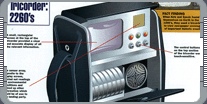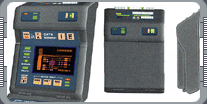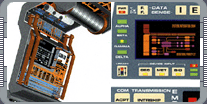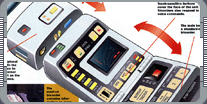
Tricorders
The tricorder of 2266 was a compact instrument that featured scanning, recording, and computing
technology.
 The tricorder of the 2260s was a small, handheld device that incorporated a video screen in the upper left
corner, and a speaker on the right. There was a series of control buttons, and it could also be activated by
voice commands.
The tricorder of the 2260s was a small, handheld device that incorporated a video screen in the upper left
corner, and a speaker on the right. There was a series of control buttons, and it could also be activated by
voice commands.
The tricorder was, in one compact unit, a portable sensor, computer, and recorder. It could detect abnormal
phenomena in the immediate area, alert the user to an alien presence, and scan through solid materials to a
depth of several thousand meters. The computer memory within the tricorder was equivalent to that of a
super-computer of Earth's late-20th century, but it came packaged in an incredibly small microchip enclosed
within the tricorder, and used an advanced form of mnemonic memory circuit which could process and store a
virtually unlimited amount of data in nanoseconds.
Depending on the specific mission, the tricorder's memory could be enhanced with special scientific and
historical programs to enable the crew to perform their tasks more effectively. The tricorder also worked
like a miniature camcorder, recording visuals, sounds, and unusual phenomena; an entire planetside mission
 could be stored for future reference. This function was performed automatically and did not require the user
to initiate the recording process. It was a 'smart' recorder, storing only key information so that the
important findings of a ground mission could be reviewed in a few minutes without having to sift through
hours of unstructured data. Upon the landing party's return to their starship following a mission, the
recorded data from their tricorders was scanned by the ship's main computer and entered into the master
databank. The tricorder became an essential part of Starfleet operations and landing party missions in
particular, where it provided personnel with an easy way of scanning new environments, unknown materials, and
new life forms. In many ways the tricorder was, and continues to be, the most important tool in Starfleet's
ongoing mission of exploration.
could be stored for future reference. This function was performed automatically and did not require the user
to initiate the recording process. It was a 'smart' recorder, storing only key information so that the
important findings of a ground mission could be reviewed in a few minutes without having to sift through
hours of unstructured data. Upon the landing party's return to their starship following a mission, the
recorded data from their tricorders was scanned by the ship's main computer and entered into the master
databank. The tricorder became an essential part of Starfleet operations and landing party missions in
particular, where it provided personnel with an easy way of scanning new environments, unknown materials, and
new life forms. In many ways the tricorder was, and continues to be, the most important tool in Starfleet's
ongoing mission of exploration.
In the 2270s Starfleet was rapidly upgrading all of its technology, including the tricorder.
 The tricorder was redesigned in the 2270s as part of a shakeup in all aspects of Starfleet life. Its basic
functions - sensing, computing, and recording - remained unchanged; the differences were more in form than in
function. The case was changed from black to platinum, with a shell of plastic polymers to strenghten it.
And the return of pockets to uniforms made carrying straps redundant; grip pads were added instead. Touch
controls were minaturized and all inputs and interfaces were located on the top surface, which was angled to
provide easy visibility when held. A simple numeric keypad dominated the interface, with a few adjoining
panels and lights. There was one monitor screen, but visual output could be imaged on one of the
multifunction panels. Sensors were located on the projected forward side. It featured only one module with
movement - a swing-down panel, sometimes decorated with a Starfleet logo. The 2270s tricorder incorporated
a thin data chip about 2.5 centimeters square and a drive slot for the chip was included along the control
panel's rear edge, on the user's side. Storage for the chip was provided by a rack located on the panel's
inside face.
The tricorder was redesigned in the 2270s as part of a shakeup in all aspects of Starfleet life. Its basic
functions - sensing, computing, and recording - remained unchanged; the differences were more in form than in
function. The case was changed from black to platinum, with a shell of plastic polymers to strenghten it.
And the return of pockets to uniforms made carrying straps redundant; grip pads were added instead. Touch
controls were minaturized and all inputs and interfaces were located on the top surface, which was angled to
provide easy visibility when held. A simple numeric keypad dominated the interface, with a few adjoining
panels and lights. There was one monitor screen, but visual output could be imaged on one of the
multifunction panels. Sensors were located on the projected forward side. It featured only one module with
movement - a swing-down panel, sometimes decorated with a Starfleet logo. The 2270s tricorder incorporated
a thin data chip about 2.5 centimeters square and a drive slot for the chip was included along the control
panel's rear edge, on the user's side. Storage for the chip was provided by a rack located on the panel's
inside face.
The continuing evolution of handheld sensing and analysis equipment has lead to the deployment of Starfleet
R&D's TR-590 tricorder X.
 Starfleet's current tricorder device measures 15.81 by 7.62 by 2.84 centimeters and masses 298.3 grams. The
casing is gamma-strengthened polyduranide. The control surfaces retain the familiar operation interface and
3.5 by 2.4 centimeter display screen. The major optronic subassemblies include the power loop, sensor
assemblies, primary processors, control and display interface, subspace transceiver assembly, and memory
storage units. Power is provided by an induction-rechargeable sarium-krellide energy cell rated for 36 hours
of continuous use with all subsystems active. This value will increase with fewer active subsystems. The
typical power level is 16.4 watts.
Starfleet's current tricorder device measures 15.81 by 7.62 by 2.84 centimeters and masses 298.3 grams. The
casing is gamma-strengthened polyduranide. The control surfaces retain the familiar operation interface and
3.5 by 2.4 centimeter display screen. The major optronic subassemblies include the power loop, sensor
assemblies, primary processors, control and display interface, subspace transceiver assembly, and memory
storage units. Power is provided by an induction-rechargeable sarium-krellide energy cell rated for 36 hours
of continuous use with all subsystems active. This value will increase with fewer active subsystems. The
typical power level is 16.4 watts.
The available sensor assemblies have been increased to 315 mechanical, EM, and subspace devices mounted about
the internal frame and embedded in the casing. 189 are clustered in the forward end for directional readings,
with a field of view lower limit of 52.3 arc-seconds. The other 126 omnidirectional devices make
measurements of the surrounding space. The previously available deployable hand sensor on the standard
tricorder has been eliminated, made obsolete by the increased resolution of the main unit.
 The TR-590 polled main computing segments (PMCS), the primary data processors, are divided among the five
inner casing surfaces and are rated at 275 giga-floating point calculations per second. The data-storage
sections include eight wafers of densified chromopolymer isolinear crystal for a total capacity of 9.12
kiloquads. The control and display interface routes commands from the panel buttons and display screen to
the PMCS for execution of tricorder functions. The opaque control surfaces are fabricated from thin-film
copper dilefinate infused with metallic dyes to fix the graphical content. The display screen incorporates a
standard nanopixel matrix similar to that used in PADDs and consoles. Communications with other data units
is provided by the STA, with range limited to 40,000 kilometers, similar to the communicator badge.
The TR-590 polled main computing segments (PMCS), the primary data processors, are divided among the five
inner casing surfaces and are rated at 275 giga-floating point calculations per second. The data-storage
sections include eight wafers of densified chromopolymer isolinear crystal for a total capacity of 9.12
kiloquads. The control and display interface routes commands from the panel buttons and display screen to
the PMCS for execution of tricorder functions. The opaque control surfaces are fabricated from thin-film
copper dilefinate infused with metallic dyes to fix the graphical content. The display screen incorporates a
standard nanopixel matrix similar to that used in PADDs and consoles. Communications with other data units
is provided by the STA, with range limited to 40,000 kilometers, similar to the communicator badge.
The difference between life and death for Starfleet personnel often rests on a small, simple-looking box
called a medical tricorder.
The underlying design of the medical tricorder is a standard tricorder - a handheld, multi-functional device
that integrates computers, scanning sensors, and data storage. Gathered information is analyzed by an
internal computer which displays the results on a small screen built into the tricorder. The differences
between a medical tricorder and the standard tricorder model lie in its dedicated life-sign sensors, medical
analysis computer, and library modules.
 It also has an optional medical peripheral (MP) device, measuring 8.5x3.0x3.0 centimeters, which is
essentially a clip-on sensor and processing device. It is powered separately and has a total operation time
of 18 hours. Housed inside the MP is a removable scanner that supplements the basic sensors by collecting
and sending high-resolution readings to the tricorder's internal sensors detect objects directly in their
path to produce information on the body's overall processes, including electromagnetic conditions, organ
functions, and dangerous organisms. The tricorder can coordinate 86 electromagnetic devices, which are
installed in its internal frame, exterior sides, and exterior top. Current medical tricorders are outfitted
with 14 nickle carbonitrium crystal wafers, three isolinear optical chips, and an interchangeable library
chip. In practical terms, this means a medical tricorder contains medical data for humans and most humanoid
types, plus information on 217 DNA-based species of non-humanoids.
It also has an optional medical peripheral (MP) device, measuring 8.5x3.0x3.0 centimeters, which is
essentially a clip-on sensor and processing device. It is powered separately and has a total operation time
of 18 hours. Housed inside the MP is a removable scanner that supplements the basic sensors by collecting
and sending high-resolution readings to the tricorder's internal sensors detect objects directly in their
path to produce information on the body's overall processes, including electromagnetic conditions, organ
functions, and dangerous organisms. The tricorder can coordinate 86 electromagnetic devices, which are
installed in its internal frame, exterior sides, and exterior top. Current medical tricorders are outfitted
with 14 nickle carbonitrium crystal wafers, three isolinear optical chips, and an interchangeable library
chip. In practical terms, this means a medical tricorder contains medical data for humans and most humanoid
types, plus information on 217 DNA-based species of non-humanoids.
|
|
"STANDARD ISSUE KIT 2266" - JANUARY 2001 ISSUE 21 STAR TREK: THE MAGAZINE
"TRICORDERS 2270" - DECEMBER 2001 ISSUE 32 STAR TREK: THE MAGAZINE
"STAR TREK: DEEP SPACE NINE TECHNICAL MANUAL"
"MEDICAL TRICORDERS" - JULY 2000 ISSUE 15 STAR TREK: THE MAGAZINE
COPYRIGHT OF PARAMOUNT PICTURES.
|